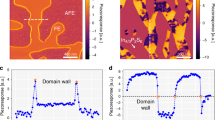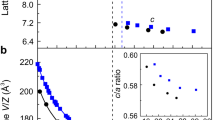Abstract
The family of layered thio- and seleno-phosphates has gained attention as potential control dielectrics for the rapidly growing family of two-dimensional and quasi-two-dimensional electronic materials. Here we report a combination of density functional theory calculations, quantum molecular dynamics simulations and variable-temperature, -pressure and -bias piezoresponse force microscopy data to predict and verify the existence of an unusual ferroelectric property—a uniaxial quadruple potential well for Cu displacements—enabled by the van der Waals gap in copper indium thiophosphate (CuInP2S6). The calculated potential energy landscape for Cu displacements is strongly influenced by strain, accounting for the origin of the negative piezoelectric coefficient and rendering CuInP2S6 a rare example of a uniaxial multi-well ferroelectric. Experimental data verify the coexistence of four polarization states and explore the temperature-, pressure- and bias-dependent piezoelectric and ferroelectric properties, which are supported by bias-dependent molecular dynamics simulations. These phenomena offer new opportunities for both fundamental studies and applications in data storage and electronics.
This is a preview of subscription content, access via your institution
Access options
Access Nature and 54 other Nature Portfolio journals
Get Nature+, our best-value online-access subscription
$29.99 / 30 days
cancel any time
Subscribe to this journal
Receive 12 print issues and online access
$259.00 per year
only $21.58 per issue
Buy this article
- Purchase on Springer Link
- Instant access to full article PDF
Prices may be subject to local taxes which are calculated during checkout




Similar content being viewed by others
Data availability
The experimental and theoretical data presented in this work are available from the corresponding authors upon reasonable request.
References
Susner, M. A., Chyasnavichyus, M., McGuire, M. A., Ganesh, P. & Maksymovych, P. Metal thio- and selenophosphates as multifunctional van der Waals layered materials. Adv. Mater. 29, 1602852 (2017).
Park, J. G. Opportunities and challenges of 2D magnetic van der Waals materials: magnetic graphene? J. Phys. Condens. Matter 28, 301001 (2016).
Du, K. Z. et al. Weak van der Waals stacking, wide-tange band gap, and Raman study on ultrathin layers of metal phosphorus trichalcogenides. ACS Nano 10, 1738–1743 (2016).
Maisonneuve, V. et al. Ionic conductivity in ferroic CuInP2S6 and CuCrP2S6. Ferroelectrics 196, 577–580 (1997).
Balke, N. et al. Locally controlled Cu-ion transport in layered ferroelectric CuInP2S6. ACS Appl. Mater. Interfaces 10, 27188–27194 (2018).
Dietrich, C. et al. Local structural investigations, defect formation, and ionic conductivity of the lithium ionic conductor Li4P2S6. Chem. Mater. 28, 8764–8773 (2016).
Morozovska, A. N., Eliseev, E. A., Morozovsky, N. V. & Kalinin, S. V. Ferroionic states in ferroelectric thin films. Phys. Rev. B 95, 195413 (2017).
Liu, F. et al. Room-temperature ferroelectricity in CuInP2S6 ultrathin flakes. Nat. Commun. 7, 12357 (2016).
Maisonneuve, V., Cajipe, V., Simon, A., Von Der Muhll, R. & Ravez, J. Ferrielectric ordering in lamellar CuInP2S6. Phys. Rev. B 56, 10860–10868 (1997).
Simon, A., Ravez, J., Maisonneuve, V., Payen, C. & Cajipe, V. B. Paraelectric ferroelectric transition in the lamellar thiophosphate CuInP2S6. Chem. Mater. 6, 1575–1580 (1994).
Bourdon, X., Grimmer, A. R. & Cajipe, V. B. P-31 MAS NMR study of the ferrielectric-paraelectric transition in layered CuInP2S6. Chem. Mater. 11, 2680–2686 (1999).
Si, M. et al. Room-temperature electrocaloric effect in layered ferroelectric CuInP2S6 for solid-state refrigeration. ACS Nano 13, 8760–8765 (2019).
Neumayer, S. M. et al. Giant negative electrostriction and dielectric tunability in a van der Waals layered ferroelectric. Phys. Rev. Mater. 3, 024401 (2019).
You, L. et al. Origin of giant negative piezoelectricity in a layered van der Waals ferroelectric. Sci. Adv. 5, eaav3780 (2019).
Katsouras, I. et al. The negative piezoelectric effect of the ferroelectric polymer poly(vinylidene fluoride). Nat. Mater. 15, 78–84 (2016).
Liu, S. & Cohen, R. E. Origin of negative longitudinal piezoelectric effect. Phys. Rev. Lett. 119, 207601 (2017).
Bernardini, F., Fiorentini, V. & Vanderbilt, D. Spontaneous polarization and piezoelectric constants of III–V nitrides. Phys. Rev. B 56, 10024–10027 (1997).
Shimada, K., Sota, T., Suzuki, K. & Okumura, H. First-principles study on piezoelectric constants in strained BN, AlN, and GaN. Jpn. J. Appl. Phys. 37, L1421–L1423 (1998).
Ondrejkovic, P., Marton, P., Guennou, M., Setter, N. & Hlinka, J. Piezoelectric properties of twinned ferroelectric perovskites with head-to-head and tail-to-tail domain walls. Phys. Rev. B 88, 024114 (2013).
Song, W. S., Fei, R. X. & Yang, L. Off-plane polarization ordering in metal chalcogen diphosphates from bulk to monolayer. Phys. Rev. B 96, 235420 (2017).
Stengel, M. & Iniguez, J. Electrical phase diagram of bulk BiFeO3. Phys. Rev. B 92, 235148 (2015).
Sharma, P. et al. Morphotropic phase elasticity of strained BiFeO3. Adv. Mater. Interfaces 3, 1600033 (2016).
Liu, K. et al. Elastic properties of chemical-vapor-deposited monolayer MoS2, WS2, and their bilayer heterostructures. Nano. Lett. 14, 5097–5103 (2014).
Woo, S., Park, H. C. & Son, Y. W. Poisson’s ratio in layered two-dimensional crystals. Phys. Rev. B 93, 075420 (2016).
Lines M. E. & Glass A. M. Principles and Applications of Ferroelectrics and Related Materials (Oxford Univ. Press, 1977).
Gruverman, A., Auciello, O. & Tokumoto, H. Scanning force microscopy for the study of domain structure in ferroelectric thin films. J. Vac. Sci. Technol. B. 14, 602–605 (1996).
Jesse, S., Baddorf, A. P. & Kalinin, S. V. Switching spectroscopy piezoresponse force microscopy of ferroelectric materials. Appl. Phys. Lett. 88, 062908 (2006).
Eliseev, E. A., Kalinin, S. V., Jesse, S., Bravina, S. L. & Morozovska, A. N. Electromechanical detection in scanning probe microscopy: tip models and materials contrast. J. Appl. Phys. 102, 014109 (2007).
Setter, N. et al. Ferroelectric thin films: review of materials, properties, and applications. J. Appl. Phys. 100, 051606 (2006).
Jungk, T., Hoffmann, A. & Soergel, E. Quantitative analysis of ferroelectric domain imaging with piezoresponse force microscopy. Appl. Phys. Lett. 89, 163507(1)–163507(3) (2006).
Balke, N. et al. Quantification of surface displacements and electromechanical phenomena via dynamic atomic force microscopy. Nanotechnology 27, 425707 (2016).
Susner, M. A. et al. High-Tc layered ferrielectric crystals by coherent spinodal decomposition. ACS Nano 9, 12365–12373 (2015).
Zavaliche, F. et al. Multiferroic BiFeO3 films: domain structure and polarization dynamics. Phase Transit. 79, 991–1017 (2006).
Baudry, L., Lukyanchuk, I. & Vinokur, V. M. Ferroelectric symmetry-protected multibit memory cell. Sci. Rep. 7, 42196 (2017).
Dieguez, O. & Vanderbilt, D. Theoretical study of ferroelectric potassium nitrate. Phys. Rev. B 76, 134101 (2007).
Yevych, R. M. & Vysochanskii, Y. M. Triple well potential and macroscopic properties of Sn2P2S6 ferroelectrics near phase transition. Ferroelectrics 412, 38–44 (2011).
Momma, K. & Izumi, F. VESTA 3 for three-dimensional visualization of crystal, volumetric and morphology data. J. Appl. Crystallogr. 44, 1272–1276 (2011).
Maisonneuve, V., Evain, M., Payen, C., Cajipe, V. B. & Molinie, P. Room-temperature crystal-structure of the layered phase Cu(I)In(III)P2S6. J. Alloy. Compd 218, 157–164 (1995).
Belsky, A., Hellenbrandt, M., Karen, V. L. & Luksch, P. New developments in the Inorganic Crystal Structure Database (ICSD): accessibility in support of materials research and design. Acta Crystallogr. B 58, 364–369 (2002).
Grimme, S., Antony, J., Ehrlich, S. & Krieg, H. A consistent and accurate ab initio parametrization of density functional dispersion correction (DFT-D) for the 94 elements H-Pu. J. Chem. Phys. 132, 154104 (2010).
Grimme, S., Ehrlich, S. & Goerigk, L. Effect of the damping function in dispersion corrected density functional theory. J. Comput. Chem. 32, 1456–1465 (2011).
Gonze, X. et al. First-principles computation of material properties: the ABINIT software project. Comput. Mater. Sci. 25, 478–492 (2002).
Kresse, G. & Furthmüller, J. Efficient iterative schemes for ab initio total-energy calculations using a plane-wave basis set. Phys. Rev. B 54, 11169–11186 (1996).
Blöchl, P. E. Projector augmented-wave method. Phys. Rev. B 50, 17953–17979 (1994).
Kresse, G. & Joubert, D. From ultrasoft pseudopotentials to the projector augmented-wave method. Phys. Rev. B 59, 1758–1775 (1999).
Grimme, S. Semiempirical GGA-type density functional constructed with a long-range dispersion correction. J. Comput. Chem. 27, 1787–1799 (2006).
Rappe, A. M., Rabe, K. M., Kaxiras, E. & Joannopoulos, J. D. Optimized pseudopotentials. Phys. Rev. B 41, 1227–1230 (1990).
Ramer, N. J. & Rappe, A. M. Designed nonlocal pseudopotentials for enhanced transferability. Phys. Rev. B 59, 12471–12478 (1999).
Monkhorst, H. J. & Pack, J. D. Special points for Brillouin-zone izntegrations. Phys. Rev. B 13, 5188–5192 (1976).
Kresse, G. & Hafner, J. Ab initio molecular dynamics for open-shell transition metals. Phys. Rev. B 48, 13115–13118 (1993).
Kresse, G. & Hafner, J. Ab initio molecular-dynamics simulation of the liquid-metal–amorphous-semiconductor transition in germanium. Phys. Rev. B 49, 14251–14269 (1994).
Neugebauer, J. & Scheffler, M. Adsorbate-substrate and adsorbate-adsorbate interactions of Na and K adlayers on Al(111). Phys. Rev. B 46, 16067–16080 (1992).
Makov, G. & Payne, M. C. Periodic boundary conditions in ab initio calculations. Phys. Rev. B 51, 4014–4022 (1995).
Acknowledgements
The experimental work, including part of the data analysis and interpretation, was supported by the US Department of Energy, Office of Science, Basic Energy Sciences, Materials Science and Engineering Division. Theory was supported by the US Department of Energy (grant no. DE-FG02-09ER46554) and by the McMinn Endowment at Vanderbilt University. The experiments were conducted at the Center for Nanophase Materials Sciences, which is a DOE Office of Science User Facility that also provided support with data collection and interpretation. Partial support for sample synthesis, experiments and theory was provided by the Laboratory Directed Research and Development program at the Oak Ridge National Laboratory. Calculations were performed at the National Energy Research Scientific Computing Center, a DOE Office of Science User Facility supported by the Office of Science of the US Department of Energy under contract no. DE-AC02-05CH11231. Manuscript preparation was partially funded by the Air Force Research Laboratory under an Air Force Office of Scientific Research grant (LRIR grant no. 14RQ08COR) and a grant from the National Research Council.
Author information
Authors and Affiliations
Contributions
J.A.B., L.T., A.O. and S.T.P. performed the DFT calculations. S.M.N., M.C., P.M. and N.B. designed and performed the PFM experiments. M.A.S. and M.A.M. synthesized the samples. S.J. provided data acquisition support. P.G. and S.V.K. provided discussion on theoretical and experimental results. All authors contributed to manuscript writing.
Corresponding authors
Ethics declarations
Competing interests
The authors declare no competing interests.
Additional information
Publisher’s note Springer Nature remains neutral with regard to jurisdictional claims in published maps and institutional affiliations.
Extended data
Extended Data Fig. 1 Pressure-induced polarization switching measured by PFM.
(a.) Pressure-dependent PFM measurements from a 10x10 μm2 area (Supplementary Fig. 6). (b.) Histograms of measured piezoelectric response of CIPS only. (c.) Pressure-dependent piezoelectric constant extracted for four distinct states and theoretical piezoelectric constant from theory for comparison. Data points are the position of the histogram peaks for each phase and error bars correspond to the peak widths. The d-value is constant or decreasing for LP and increases for HP. The +HP state (light blue) transforms into the -HP state (yellow) indicating a pressure-induced switching event. All changes are reversible. Response on the IPS phase changes little with contact force (see also Supplementary Fig. 7b).
Supplementary information
Supplementary Information
Supplementary Figs. 1–8.
Rights and permissions
About this article
Cite this article
Brehm, J.A., Neumayer, S.M., Tao, L. et al. Tunable quadruple-well ferroelectric van der Waals crystals. Nat. Mater. 19, 43–48 (2020). https://doi.org/10.1038/s41563-019-0532-z
Received:
Accepted:
Published:
Issue Date:
DOI: https://doi.org/10.1038/s41563-019-0532-z
This article is cited by
-
Realization of sextuple polarization states and interstate switching in antiferroelectric CuInP2S6
Nature Communications (2024)
-
Two-dimensional ferroelectrics from high throughput computational screening
npj Computational Materials (2023)
-
Towards two-dimensional van der Waals ferroelectrics
Nature Materials (2023)
-
Domain-dependent strain and stacking in two-dimensional van der Waals ferroelectrics
Nature Communications (2023)
-
In-plane ferroelectric tunnel junctions based on 2D α-In2Se3/semiconductor heterostructures
npj Computational Materials (2023)



